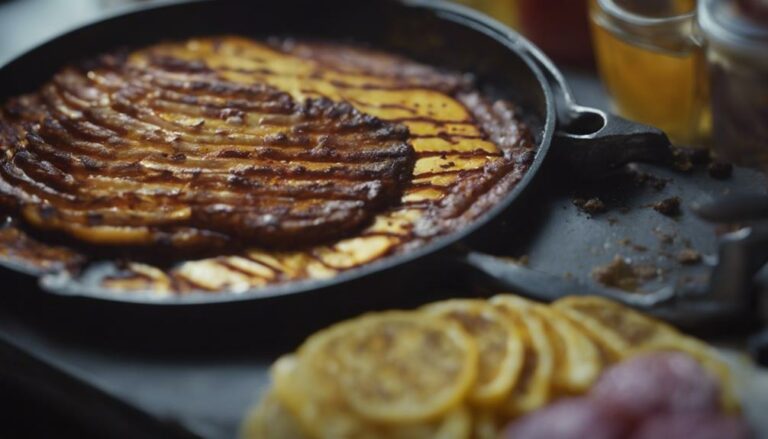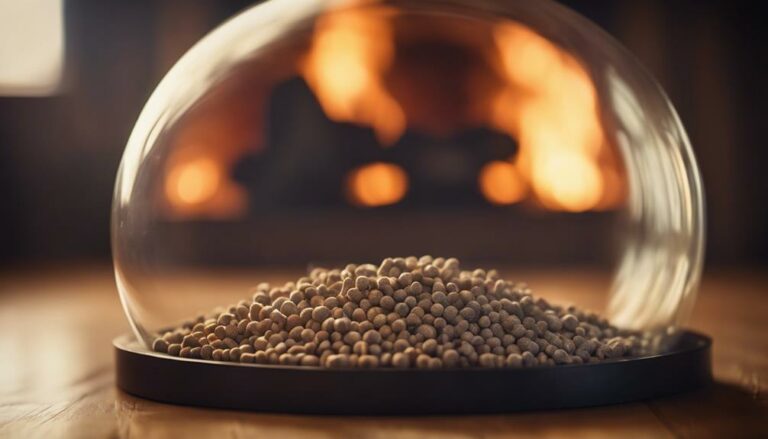Mastering the art of low and slow BBQ is like uncovering a hidden treasure trove of mouthwatering flavors and melt-in-your-mouth tenderness. It takes precision, knowledge, and a genuine passion for the craft of barbecue. In this article, we will guide you through the step-by-step process of choosing the perfect meat, preparing your smoker, selecting the ideal wood, and achieving optimal temperature control. With patience and skill, you can unlock the mastery of low and slow BBQ, taking your culinary skills to new heights.
Table of Contents
Key Takeaways
- Low and slow BBQ involves cooking meat at a low temperature over a long period of time, resulting in tender and flavorful meat.
- Choosing the right cut of meat is crucial for low and slow BBQ, as tougher cuts benefit from the slow cooking process.
- Properly preparing and maintaining your smoker is essential for achieving consistent temperature control and preventing unwanted flavors.
- Selecting the right wood for smoking is important, as different types of wood impart different flavors to the meat. Experimentation is key to finding your preferred flavor profile.
“Unlocking the secrets of low and slow BBQ is a journey that requires patience, practice, and a genuine love for the craft.”
What is Low and slow BBQ?
Low and slow BBQ is a technique that involves cooking meat at a low temperature over a long period of time. This method allows the flavors to develop slowly and the connective tissues to break down, resulting in incredibly tender and flavorful meat. It’s a time-honored tradition that requires attention to detail and a deep understanding of the cooking process.
When it comes to choosing the right meat for low and slow BBQ, it’s important to select cuts that are well-suited for this method. Tougher cuts of meat, such as pork shoulder or beef brisket, are ideal as they benefit from the slow cooking process, becoming tender and juicy. It’s also crucial to properly season the meat, allowing the flavors to penetrate and enhance the overall taste.
Preparing your smoker is another crucial step in the low and slow BBQ process. Whether you’re using a traditional charcoal smoker or a modern pellet smoker, it’s important to ensure that your equipment is clean and properly maintained. This will help maintain a consistent temperature throughout the cooking process and prevent any unwanted flavors from affecting the meat.

Selecting the right wood for smoking is also essential. Different types of wood impart different flavors to the meat, so it’s important to choose wisely. Popular options include hickory, mesquite, and applewood, each offering its own unique flavor profile. Experimentation is key here, as you can mix and match different woods to create your own signature taste.
One of the most important aspects of low and slow BBQ is mastering temperature control. Maintaining a consistent temperature throughout the cooking process is crucial for achieving perfectly cooked meat. Whether you’re using a digital thermometer or a traditional analog thermometer, it’s important to monitor the temperature closely and make any necessary adjustments.
In conclusion, unlocking the secrets of low and slow BBQ is a journey that requires patience, practice, and a genuine love for the craft. By following the steps outlined in this article, you can elevate your barbecue skills and create mouthwatering dishes that will impress your friends and family. So fire up your smoker, grab your favorite cuts of meat, and get ready to embark on a culinary adventure like no other.
Choosing the Right Meat
When it comes to low and slow BBQ techniques, selecting the right cut of meat is crucial for achieving tender and flavorful results. The choice of meat can make a significant difference in the final product.
One important factor to consider is the formation of a smoke ring. This thin, pink layer around the edges of the meat indicates that it has been perfectly smoked, adding both visual appeal and depth of flavor.
Another crucial consideration is meat tenderness. Different cuts of meat have varying levels of collagen and connective tissue, which can affect how tender the meat becomes during the slow cooking process. Opting for cuts with more marbling or fat content can result in a juicier and more tender final product.
Understanding the characteristics of each cut and their suitability for different BBQ techniques is essential for achieving the best results.
In the context of low and slow BBQ, choosing the right meat involves considering factors such as smoke ring formation and meat tenderness.
Preparing the Smoker
To achieve the best results in low and slow BBQ techniques, it’s important to carefully prepare the smoker. Proper maintenance of the smoker is crucial for getting that perfect flavor and tenderness in your barbecued meats.
Before you start using the smoker, make sure it’s clean and free from any leftover ashes or grease. This will prevent any unwanted flavors or odors from affecting the taste of your food.
Additionally, check the seals and gaskets of the smoker to ensure there are no leaks that could impact temperature control.
When choosing charcoal, consider using hardwood lump charcoal or high-quality briquettes. Hardwood lump charcoal burns hotter and adds a distinct smoky flavor, while good-quality briquettes provide consistent and long-lasting heat. The type of charcoal you use can greatly influence the taste and texture of your BBQ.
Selecting the Perfect Wood for Low and Slow BBQ
When it comes to achieving the desired flavor and aroma in your barbecued meats using low and slow BBQ techniques, choosing the right wood is essential.
Different types of wood impart different flavors, ranging from mild to strong, so it’s important to select the perfect wood for your specific dish.
In this discussion, we will explore the best wood types for BBQ and provide guidance on how to choose the ideal wood for your next cookout.
Best Wood Types
Choosing the right wood type is essential for achieving the perfect low and slow BBQ results. Different smoking methods require different wood types, each offering its own distinct flavor.
Let’s take a look at the advantages and disadvantages of some popular wood types:
- Fruitwoods:
- Pros: These woods impart a sweet and mild flavor, making them great for delicate meats like poultry and fish.
- Cons: They burn relatively quickly, so you’ll need to add more wood frequently.
- Hardwoods:
- Pros: Hardwoods provide a stronger and smokier flavor, making them ideal for beef and pork.
- Cons: They can overpower the taste of lighter meats, and they require longer cooking times.
Understanding the characteristics of different wood types will help you choose the perfect one for your low and slow BBQ. Through experimentation and experience, you’ll become a master at selecting the best wood for your BBQ creations.
How to Choose?
Choosing the perfect wood for low and slow BBQ requires careful consideration and knowledge of the different wood types available. The wood you choose greatly affects the flavor and aroma of your BBQ. Each wood has its own smoke intensity and unique flavor profile, so it’s essential to select the right one to enhance the taste of your meat.
To help you make an informed decision, here is a table showcasing some popular wood types and their characteristics:
- Mesquite: High smoke intensity with a strong, earthy flavor.
- Hickory: Medium to high smoke intensity with a rich, bacon-like flavor.
- Apple: Medium smoke intensity with a sweet, fruity flavor.
- Cherry: Low to medium smoke intensity with a mild, slightly sweet flavor.
When selecting wood, consider the type of meat you’re cooking and your personal preference. Experimenting with different wood types can lead to exciting new flavor combinations.

Seasoning and Rubs
When it comes to achieving delicious flavors in low and slow BBQ, seasoning and rubs play a vital role. The right combination of spices and herbs can elevate the natural flavors of the meat, creating a mouthwatering experience.
In this discussion, we will explore the different types of BBQ rubs and seasoning techniques that can take your BBQ to the next level. Let’s dive in and discover the secrets behind creating incredible BBQ flavors.
Best BBQ Rubs
Enhancing the flavor of low and slow BBQ dishes can be achieved by using a carefully crafted blend of seasonings and rubs. BBQ rubs consist of a combination of herbs, spices, and other ingredients that add depth and complexity to the meat. While there are numerous store-bought options available, creating your own homemade rubs can take your BBQ to the next level.
To help you in this endeavor, here are two sub-lists featuring ingredients for BBQ rub recipes and tips for creating homemade rubs:
Ingredients for BBQ Rub Recipes:
- Salt
- Brown sugar
- Paprika
- Garlic powder
- Onion powder
- Black pepper
- Chili powder
- Cayenne pepper
Tips for Homemade Rubs:
- Experiment with different ratios of ingredients to find your preferred flavor profile.
- Store your homemade rubs in airtight containers to maintain their freshness.
- Apply the rub generously to the meat and let it sit for at least an hour before cooking to ensure maximum flavor penetration.
Seasoning Techniques Explained
To achieve the best results in low and slow BBQ cooking, it’s important to understand and use effective seasoning techniques. Seasoning plays a crucial role in infusing smoke and enhancing the flavor of your BBQ dishes.
There are various methods you can use to season your meat, including dry rubs, wet rubs, and marinades. Dry rubs are a mixture of herbs, spices, and seasonings that you apply directly to the meat’s surface.
Wet rubs, on the other hand, typically include oil or another liquid to create a paste-like consistency, which enhances the flavor and moisture of the meat.
Marinades involve soaking the meat in a mixture of liquid and seasonings for an extended period, allowing the flavors to penetrate deeply.

The Art of Temperature Control
Mastering temperature control is a vital aspect of achieving exceptional results with low and slow BBQ techniques. The ability to maintain the ideal balance of heat is essential for creating succulent, flavorful meats and achieving that coveted smoke ring.
To truly grasp the art of temperature management, it is important to consider the following factors:
- Airflow: Proper airflow plays a crucial role in maintaining a consistent temperature. By adjusting the dampers on your smoker or grill, you can control the amount of oxygen and, in turn, regulate the heat.
- Fuel: Different fuels have varying burning temperatures. Whether you’re using charcoal, wood, or pellets, each requires specific techniques to control the heat output effectively.
- Heat Indicators: Utilizing a dependable thermometer is key to accurately monitoring and adjusting the temperature. Ensure the probe is inserted into the thickest part of the meat for precise readings.
Patience Is Key: the Long Cook
Achieving a successful long cook in low and slow BBQ techniques requires a steadfast commitment to patience. Slow cooking offers a multitude of benefits – it allows for the development of rich and complex flavors, tenderizes tough cuts of meat, and results in a melt-in-your-mouth texture that is truly unmatched.
To ensure a successful long cook, here are some essential tips:
- Choose the right cut of meat: Opt for cuts like brisket or pork shoulder that can withstand the lengthy cooking process while still delivering exceptional taste and tenderness.
- Maintain a consistent temperature: Use a reliable thermometer to monitor the temperature throughout the cook. This will help you achieve the perfect balance of heat and time, resulting in a delicious outcome.
- Resist the temptation to peek: Opening the smoker too frequently can cause temperature fluctuations and prolong the cooking time. Trust the process and resist the urge to check on the meat too often.
- Allow for ample resting time: After the long cook, give the meat enough time to rest. This resting period allows the flavors to intensify and ensures maximum tenderness and juiciness.
Mastering the Resting Period
During the resting period, it is important to allow the cooked meat to rest for a sufficient amount of time to enhance the flavors and ensure optimal tenderness and juiciness. This critical step in the BBQ process allows the meat to relax and reabsorb its juices, resulting in a more delicious and flavorful final product.
To truly excel at flavor infusion and achieve tender meat, consider the following:
- Resting time: Aim for a resting period of at least 15-30 minutes for smaller cuts and up to an hour for larger cuts. This allows the juices to redistribute evenly throughout the meat, enhancing both taste and texture.
- Foil or butcher paper: Wrapping the meat in foil or butcher paper during the resting period helps to retain heat and moisture, further improving tenderness.
- Temperature control: Keep the meat in a warm place during the resting period, such as in a cooler wrapped in towels or in a preheated oven set to a low temperature. This ensures that the meat stays warm without overcooking.
Frequently Asked Questions
Can I Use Any Type of Meat for Low and Slow BBQ Cooking?
Different cuts of meat can be used for low and slow BBQ cooking, each with its own unique qualities. It’s important to understand the different cuts of meat and how marinating them can affect the outcome when using this cooking technique.
How Often Should I Clean My Smoker?
How often should you clean your smoker? Cleaning your smoker after each use is recommended to ensure optimal performance and flavor in your BBQ. Regular cleaning prevents buildup and promotes even heat distribution, resulting in delicious and evenly cooked meals. Additionally, seasoning the smoker not only enhances its longevity but also imparts a rich and smoky flavor to your BBQ creations. By taking the time to clean and season your smoker regularly, you’ll be able to enjoy mouthwatering BBQ every time you fire it up.
Is It Necessary to Soak Wood Chips Before Using Them in the Smoker?
The question of whether or not to soak wood chips before using them in a smoker is a topic that sparks debate among BBQ enthusiasts. Some argue that soaking enhances the flavor of the smoke, while others believe it is unnecessary and may impede airflow. Ultimately, finding the perfect balance for achieving the desired smoke flavor in low and slow BBQ cooking requires experimentation. So, it’s worth trying both methods and seeing which one works best for you.
How Long Should I Let the Meat Rest After It’s Done Cooking?
It is crucial to let meat rest after cooking as this allows the juices to redistribute and the flavors to develop. The recommended duration for resting meat can vary depending on its size and type, but generally, it is advised to let it rest for 10-20 minutes. This resting period helps to ensure a more flavorful and juicy final result. So, next time you cook meat, remember the importance of giving it some time to rest before diving in.
Can I Use Store-Bought Rubs and Seasonings for Low and Slow BBQ Cooking?
Using store-bought rubs and seasonings for low and slow BBQ cooking can offer an exciting opportunity to explore different flavors. By experimenting with homemade blends, you can customize your dishes and create a unique culinary experience. Don’t be afraid to get creative and try new combinations to enhance the taste of your BBQ. Making your own rubs and seasonings allows you to have full control over the ingredients and tailor them to your preferences. So why not add a personal touch to your BBQ and elevate your cooking game?










